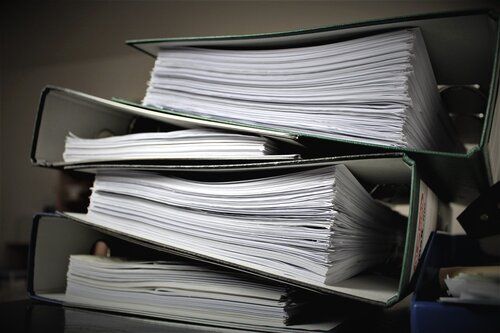7 real costs of not going paperless
'Going paperless' is no longer just a buzzword in business today. Companies all over the globe are ditching their old school paper workflows and storage systems and are enjoying the productivity, efficiency, and cost savings that a digital office can bring.
However, a less-considered - but equally valuable - benefit is the environmental impact of going paperless. As climate damage becomes an increasingly prominent global issue and businesses look to adopt more sustainable practices, reducing paper consumption and waste seems to be one obvious answer. This is particularly so when you consider that paper production is one of the world's largest consumers and polluters of fresh water.

So, why hasn't everyone made the switch already? There are many reasons. One is that some businesses may not know or understand available technology, or they may simply be daunted by the concept of digitisation. Some may have low trust in going digital and are afraid it may be a risk to business security. Others may simply have a hard time breaking old habits or believe that paper records are a legal requirement.
Most, however, simply don't have a full understanding of the benefits of adopting a digital office and, in particular, the real cost of not going paperless. Here's what not going paperless can cost your business.
1. Your Data is at Greater Risk
With the heightened awareness of cybercrime, it may seem counter-intuitive to digitise your files. However, as long as you keep your technology up to date, their safety is assured far more than if you kept your sensitive paper files in an office. Documents stored in the cloud are encrypted and protected by multiple layers of cloud security. They also have restricted access and audit trails to keep track of who is accessing the files and when. Paper documents - such as invoices and time sheets - kept in an office are at risk to fire, flood, theft, or simply being lost in a sea of paper. In fact, statistics indicate that 40% of data breaches are paper-based.

2. You Use More Space
Record-keeping laws dictate that all records have to be kept by a business for a minimum number of years, but this doesn't mean they have to be on paper. While a single piece of paper takes up no space at all, these records easily multiply to reach the thousands and then become a significant user of office space. Reducing bulky and complicated filing systems can free up a surprising amount of space in the office; a standard four-drawer filing cabinet can take up to 1.2 square metres of floor space, including the area needed to open a drawer.
This can result in you paying rent on space that could be put to much better use. Plus, of course, the clutter associated with a paper-based workflow (just have a look at the desks around you).
3. Sourcing Paper Records Takes More Time
There are many ways that going paperless can save you a lot of valuable time. When everything is digital you have the luxury of a quick Ctrl+F search to find exactly what you need, instead of trawling through piles of physical documents spread across various filing cabinets, only to find that what you need has been accidentally put back in the wrong place. It's estimated that the average manager spends four weeks a year hunting for paper records!
4. Staff Are Tied to Your Office
Digital files also give you the freedom to have a mobile workforce who aren't tied to the office because of a paper-based workflow. With modern technology, employees can access files and applications anywhere, anytime and on any device as long as they have an internet connection. There is also the benefit of no longer having to wait days or even weeks for invoices, contracts and other forms to be filled out, scanned and sent back. A digital document can be completed and returned almost immediately, leaving you with satisfied customers.

5. Your Cash Flow is Slower and Harder to Manager
82% of small businesses fail due to poor cash flow management. As paper-based workflows and documents are less efficient, having to move around physically, your cash flow management is impeded by paper. For example, if staff are on the road completing work orders on paper, and have to hand deliver these to your office for invoicing, you could have potential cash laying around in your employees cars for a week before they're invoiced to your clients. Going paperless means you can eliminate these delays and receive income at greater speed.
6. A Reputation for Not Being Environmentally Aware
A paperless office is a much more eco-friendly office. Not only does paper production require the cutting down of forests, but the making of paper is also extremely environmentally unfriendly. By going paperless, not only can you rest easy knowing you're reducing your business' environmental impact, but 55% of global customers are also more likely to pay more for your services knowing that you care enough to go paperless.
Why Azzuri Concrete Went Paperless
One Australian business that has successfully made the move to paperless workflows with the help is Azzurri Concrete. This success was achieved by digitising and storing in the cloud 29 different forms used by Azzurri using eForm software. An internal notification system was also set up to inform the relevant department whenever a form was submitted.
The result is a significantly more streamlined documentation system, leading to a more than $180,000 savings in staffing costs and a greatly improved cash flow. Other results have been a reduction in admin work by 60-80 hours a week, a 90% decrease in lost forms, a 100% decrease in inaccurate data entry, and the opportunity to provide same-day invoicing.
If you would like to see results like these, contact us now to see how we can help you make the transition to a paperless office and take your business to the next level.
With an ROI like this, it's easy to see why businesses like Azzurri Concrete are making the move to digitisation to speed up and future-proof their operations. The adoption of this technology is increasing each year, so rather than it being a competitive advantage, it is fast becoming the new benchmark for business operations.